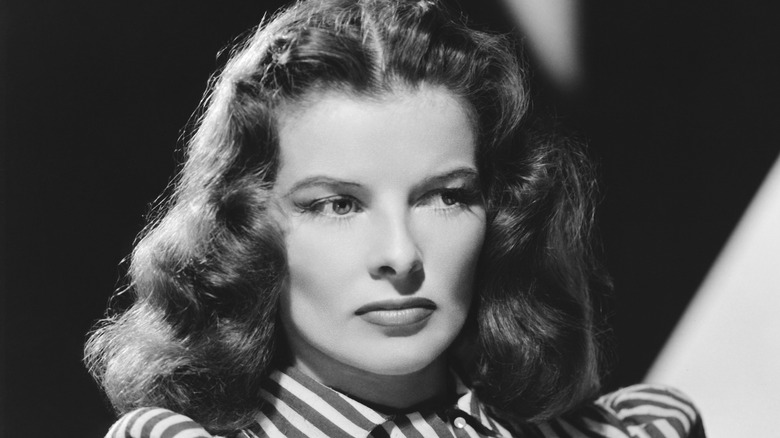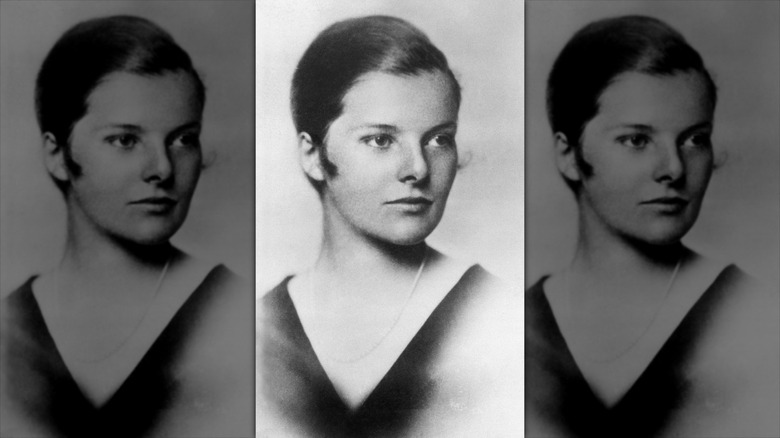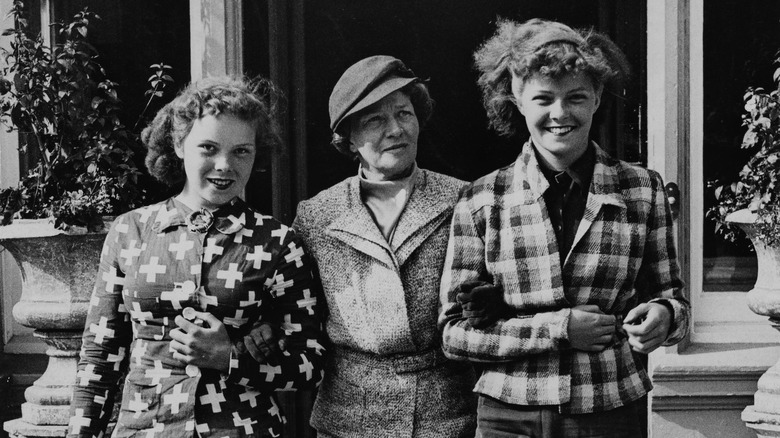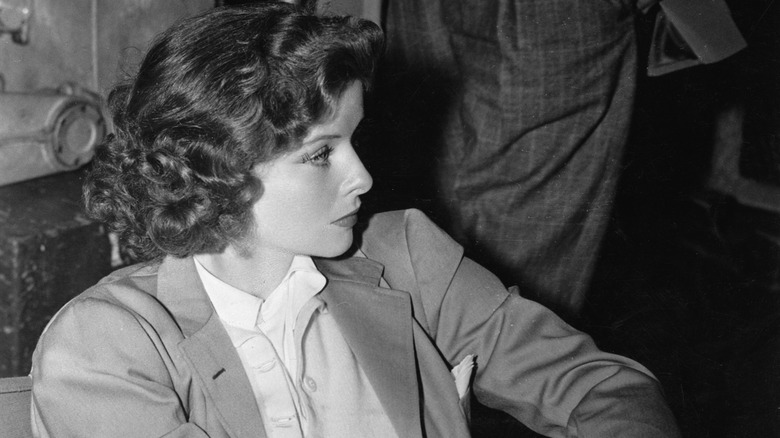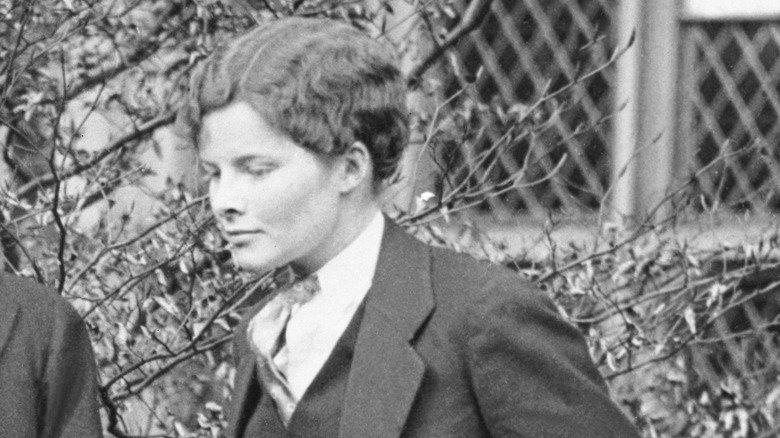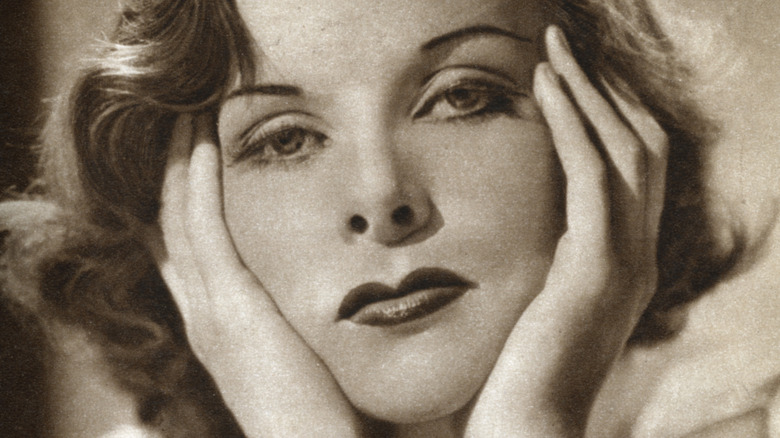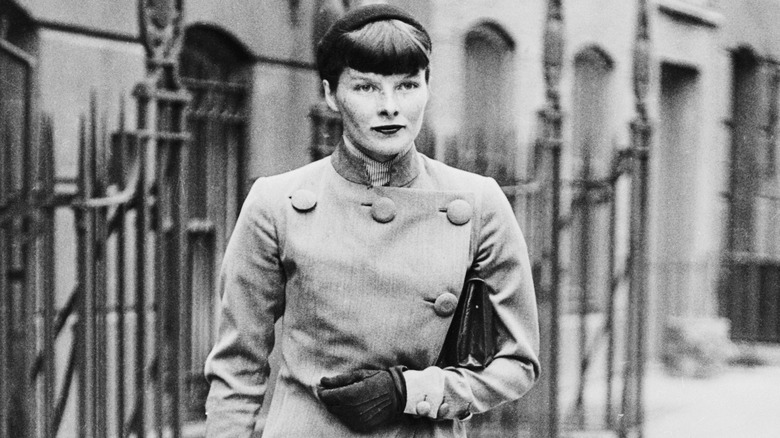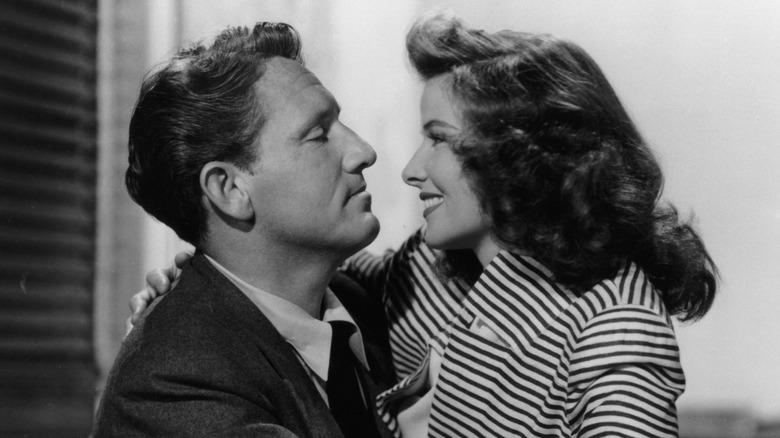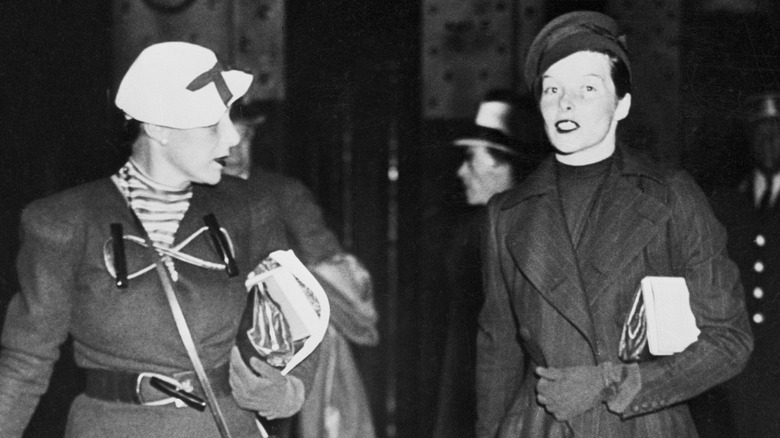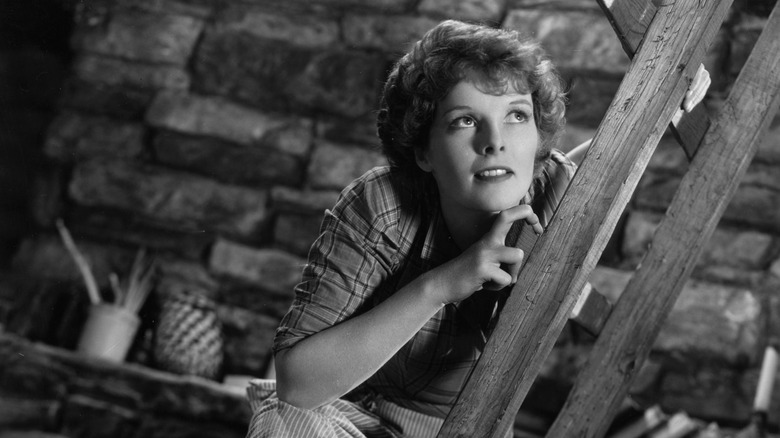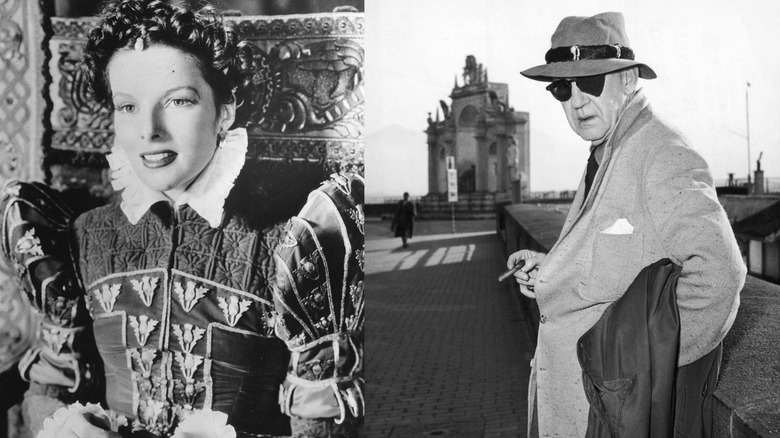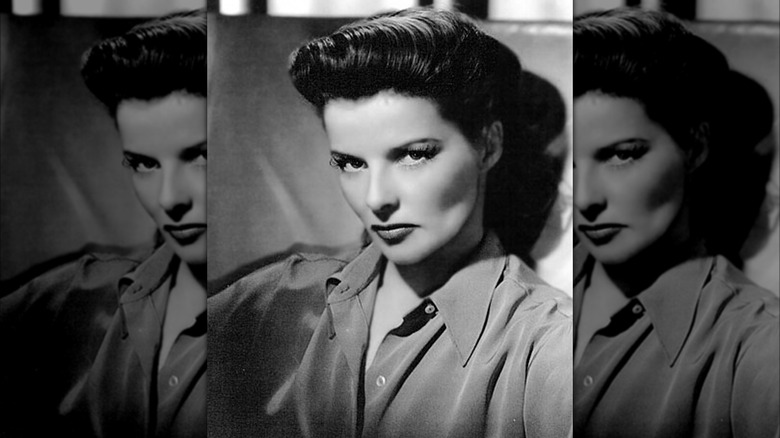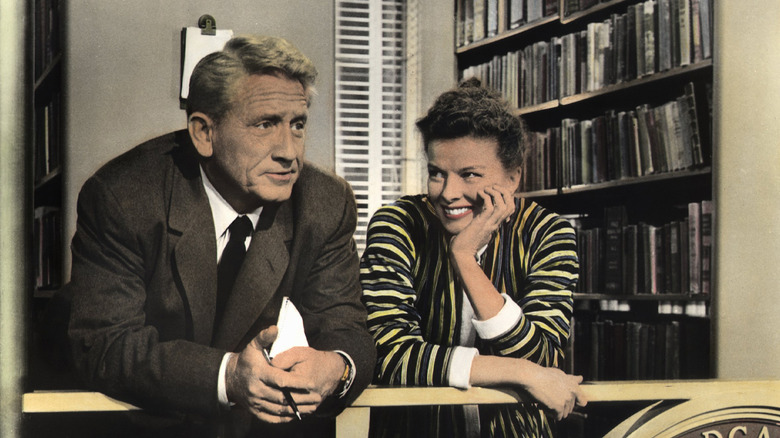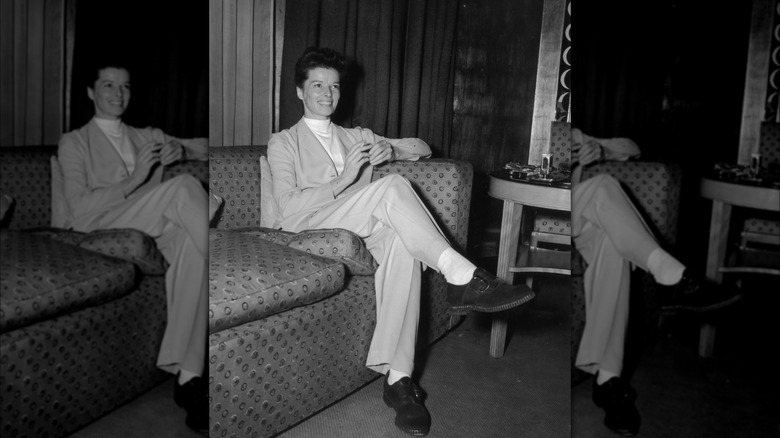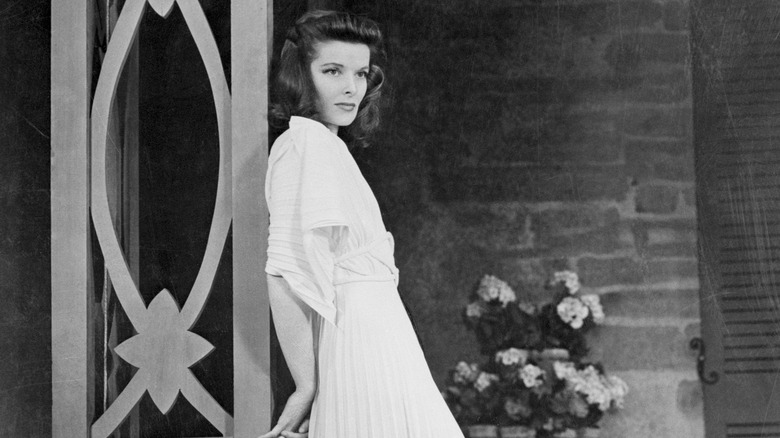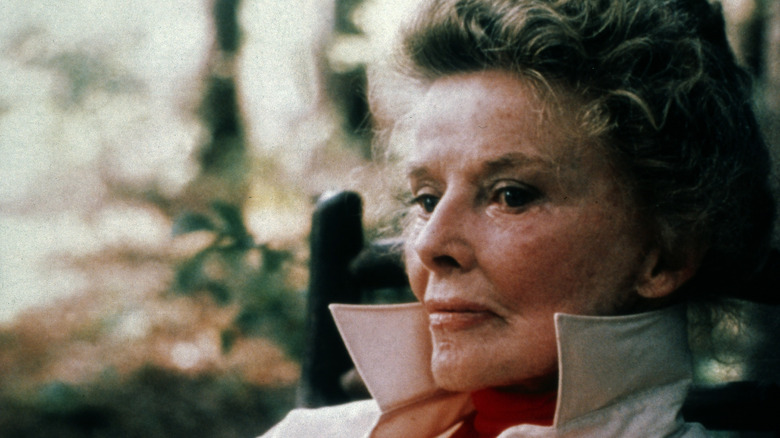Tragic Details About Katharine Hepburn's Life
The following article contains references to suicide.
Katharine Hepburn was best known for her roles in movies like 1933's "Little Women," 1938's "Bringing Up Baby," 1940's "The Philadelphia Story," and 1967's "Guess Who's Coming to Dinner" — just to name a few of her career's biggest hits.
While the Golden Age star's onscreen persona was all melodrama and romance, with her film appearances almost always including a love story with one of Hollywood's leading hunks of the day, the reality of Hepburn's life was not always sunshine and roses. In fact, from the time she was a young child up until her final days, the actor's life was marked by tragic circumstances. Despite all the glitz and glamour attached to her image, it's important to remember that a real woman was behind the black-and-white Hollywood-produced façade.
Let's explore some of the lesser-known experiences that helped make this icon the woman she was.
She discovered her brother's body when she was only 13
What has been regarded by many, including her friends and family, as the chief tragedy of Katharine's life was the death of her older brother Tom at 15 years old. The painful incident would follow the star all her life and repeatedly came up in her interviews toward the end of her life.
It was spring 1921, and Katharine and Tom were enjoying the Easter holidays at their godmother Mary Towle's home in Greenwich Village, away from their parents and four other siblings. After eating breakfast with Mary, 13-year-old Katharine was asked to wake her brother for fear that the two siblings would miss their train back home to Connecticut. As the story goes, Katharine ran to the attic bedroom where Tom had been staying. She knocked on the door, but there was no answer. She knocked again and called his name, but was only met with silence.
When the teenager opened the door, her life was irrevocably changed. She discovered that her older brother had died by suicide. It's undeniable that this experience traumatized Katharine. Years later, she revealed, "After Tom was gone, I believe my personality changed. I went from being totally open to life to being closed to life. You might say ingrown, sort of like a toenail can get when your shoe is too small" (via Express).
If you or someone you know is struggling or in crisis, help is available. Call or text 988 or chat 988lifeline.org
Her father refused to see Tom's death as a suicide
Prior to Tom's death, there had been signs that the eldest Hepburn son was struggling with his mental health. In 1920, his parents found him with a noose around his neck in their family home; however, the 14-year-old claimed that he was attempting a stunt, according to Vanity Fair.
While this event might have raised alarm bells for some, the steely Dr. Hepburn chose to believe his son's story. His powers of denial were so strong that even when Tom eventually did die by suicide, the well-known doctor refused to admit that the tragedy was anything but a prank gone wrong. In the days following Tom's death, The New York Times ran a story recounting the tragedy from Dr. Hepburn's perspective. The headline read, "SAYS SON'S HANGING WAS BOYISH 'STUNT'; Dr. Hepburn Now Believes Lad Strangled When Rehearsing Trick After Visit to 'Movies.'"
While Katharine never spoke about how her father's behavior during this time affected her, it was clear to those around her that Tom's death and the spectacle surrounding it took its toll. In his later years, Katharine and Tom's brother Bob recounted how he witnessed Katharine throw herself into her studies and grow closer to her father. Most telling of all, Katharine began celebrating her birthday on November 8 — Tom's birthday — rather than her own birth date of May 12.
Numerous other members of her family died by suicide
In 2021, a wide-ranging scientific study produced proof that suicide might have a genetic link. Together, scientists at Mount Sinai were able to identify a chromosome variation that, if present in an individual's DNA, increased the likelihood that they will attempt suicide in their lifetime. This study gives empirical evidence to a long-held belief that suicide runs in families. While it's unknown whether the Hepburns had this chromosome variation, a number of suicides were a part of their family history.
In the time since Katharine's natural death in 2003, biographers discovered that in addition to her older brother Tom's death, four other notable suicides occurred. Fred Houghton, Katharine's maternal grandfather, died by suicide in 1892, with the nature of his death kept secret from his grandchildren. Additionally, Katharine's great uncle on her mother's side, Charlie Houghton, died by suicide in 1897. On her father's side of the family, Katharine's uncles, Charlie Hepburn and Dr. Sewell Hepburn, died by suicide in 1915 and 1921, respectively.
With this series of tragedies in her family history, Katharine's ambition and sense of control over her own life can be viewed as a way to break the cycle of misfortune and grief that seemed to haunt her from both sides of her family.
She wanted to become a doctor in memory of her brother but struggled with the coursework
Even years after her brother Tom's death, the tragic circumstances of his end continued to haunt Katharine Hepburn. Many people who knew and loved Katharine claim that the loss of Tom changed the course of the actor's life, leading her to make decisions that she otherwise might not have made. One of these was her dream of becoming a doctor. Biographer Barbara Leaming theorized in Vanity Fair that although antithetical to Katharine's unstudious nature, the actor chose this career path as a way to honor her sibling, as Tom planned to become a physician.
Although Katharine began attending Bryn Mawr College, a prestigious liberal arts school for girls, her dream of becoming a doctor didn't last long. After struggling with a basic chemistry course and receiving poor marks in other classes, the young Hepburn changed course.
While this was surely a large blow to the ambitious Katharine, this decision eventually freed her up to explore other opportunities college life offered, and eventually, she found her real life's passion. After leaving medicine behind, the future star found her footing in Bryn Mawr's theater department. After graduation, she became involved in the New York theater scene.
Her introduction to theater was like 'a slow walk to the gallows'
Although Katharine Hepburn is now remembered as an icon of the screen, she got her start on the stage. While most of us are familiar with the story of the scrappy young starlet starting out on the bottom and climbing her way to the top, not many fans are truly aware of just how unhappy Hepburn was during her early theater days.
In 1933, she starred in a play titled "The Lake." The director, Jed Harris, was a mainstay on the New York theater scene from the 1920s to the 1950s. However, in The Paris Review, writer Lindsay Nordell described the director as a "sadist" who unleashed "abusive behavior" on the young Hepburn.
While audiences praised the 26-year-old's performance, the play was an overall failure. Ticket sales were declining and reviews in the papers let out a resounding "meh." Despite its name, "The Lake" had made no great ripple on Broadway. In light of these disappointments and growing tension between herself and the play's director, Hepburn made the decision to buy her way out of her contract and leave the production early. It was a desperate move, with The Paris Review explaining that Hepburn essentially signed away all of her savings. Looking back on this era decades later, Hepburn wrote in her autobiography, "Me: Stories of My Life," that "it was a slow walk to the gallows."
Her first marriage ended in divorce
Despite the tabloids abounding in rumours of Katharine Hepburn's love affairs, the screen legend only said "I do" once. In 1928, she married businessman Ludlow Ogden Smith. In a different universe, the two may have been a match made in heaven, but the up-and-coming actor was too fiery a personality for the gentle-spirited young man from New England.
Decades later, Bob Hepburn would report that his older sister was a "natural boss" and overpowered her starry-eyed beau, according to Vanity Fair. The power dynamics were so out of sync that Hepburn even convinced her new husband to drop the "Smith" from his name to make it more interesting. In an unconventional switcheroo, the young man changed his name to Ogden Ludlow to please his new bride.
No one was surprised that this union didn't last. In 1932, Katharine's reputation on the stage won her a role in her first film — "A Bill of Divorcement." Ogden Ludlow became a disappearing image in the rearview mirror as Hepburn struck up an affair with the agent Leland Hayward. She flung off the title of wife for good when she divorced Ludlow in 1934.
She was never able to marry her longtime partner
In her 1996 autobiography, "Me: Stories of My Life," Katherine Hepburn referenced one of the greatest affairs of her life, writing, "It was a unique feeling that I had for S.T. I would have done anything for him."
S.T., or Spencer Tracy, and Hepburn met when they were cast as love interests in 1942's "Woman of the Year." The romantic comedy follows the story of two journalists whose unexpected romance throws a wrench in their career-driven lives. It was a raucous success, with Hepburn and Tracy's real-life connection bleeding into their performances. Audiences went rabid for what they could tell was genuine attraction. The studios jumped on this, producing more Hepburn-Tracy team-ups. In total, the actors starred in nine films together.
Behind the scenes, a love affair quickly turned into a long and devoted partnership. As she detailed in her autobiography, the couple "passed twenty-seven years together in what was to [her] absolute bliss." Sadly, though, she was never able to marry Tracy. Despite their once-in-a-lifetime connection, Tracy was a devout Catholic and refused to divorce his wife. His fear of divine punishment was only worsened when his son, John, was diagnosed as deaf not long after birth. Tracy felt that this diagnosis was God's way of punishing him for his sins, according to Biography.
Rumors about her love life persisted during her life and after
One aspect of Katharine Hepburn's life that seemed to draw the most interest were her romantic interests. Possible romances have been suggested in the many biographies that have come out since Hepburn's death. William J. Mann, the author of "Kate: The Woman Who Was Hepburn," has suggested that Katharine Hepburn's romance with Spencer Tracy was nothing more than a convenient partnership that allowed both parties to hide their true sexualities.
Rumors about Hepburn's sexuality followed the actor throughout her entire career; however, Mann asserts that these claims weren't fabricated out of thin air. On the contrary, Laura Harding, one of Hepburn's close associates, reportedly called herself "Miss Hepburn's husband." Additionally, much of her life was spent with a companion, Phyllis Wilbourn, who stood by Hepburn for 40 years. According to Mann, Hepburn said, "Phyllis and I are one."
We may never know whether these relationships were romantic in nature, but if so, living in the closet during a deeply homophobic time would have been a painful experience for the actor.
At one point, she suffered from the 'Hepburn stigma'
In the 1930s and 1940s, Hollywood operated on what is now called the studio system. It was a successful business method in which film studios had the final say over every aspect of the movie-making process. Instead of hiring writers, directors, or actors on a freelance basis, these individuals were essentially employed permanently by the studio and sent out to jobs when and where the studio bosses saw fit.
A crucial branch of the studio system was the so-called "star system," where unknown actors were swooped up by the studios and meticulously crafted to fit a stereotype deemed profitable by the powers that be. There were actors molded to be the "boy next door" to appeal to younger girls, or sultry screen sirens who played the vixen or murderess in every film they were cast in. Hepburn's stereotype offered a little more flexibility, but she was mostly typecast as a strong-willed, witty young woman in screwball comedies or romantic heroines in literary adaptations.
This plan worked for a while, catapulting Katharine Hepburn to top billing and earning a lot of people quite a bit of money along the way. However, in the mid-1930s, Hepburn starred in a string of underperforming films. "Spitfire," "The Little Minister," and "Break of Hearts" all produced negative reactions from audiences, causing studio insiders to coin the phrase the "Hepburn stigma," biographer Barbara explained in Vanity Fair. The star eventually broke her losing streak, but for a while, the name "Hepburn" was a dirty word in Hollywood.
She was rejected by John Ford
Although Katharine Hepburn is most remembered for her on- and offscreen partnership with actor Spencer Tracy, Hepburn also had an affair with the famed director John Ford. They first met in 1932, when Ford was in the audience watching a then-undiscovered Hepburn star in the Broadway play "The Warrior's Husband." The big Hollywood player was interested in this talented new starlet and it wasn't long before he was inviting Hepburn to a screen test for a film adaptation of "The Warrior's Husband."
What followed was a winding, complicated love affair. At the beginning of their relationship, Ford told the ingénue, "You're a hell of a fine girl; you'd probably make somebody a nice wife" (via Vanity Fair). However, this hint of a marriage proposal would never come to fruition. Ford was already married and had been for many years, and the couple shared two children. Despite this, the affair continued, becoming an open secret around Hollywood.
Despite the heartbreak that Hepburn must have felt being her lover's mistress, we can thank the Hepburn-Ford romance for 1936's "Mary of Scotland." In this epic historical romance directed by Ford, we see Hepburn step into her full regalness. The flick was a hit and did wonders to shake off the "Hepburn stigma." Behind the scenes, though, Ford was tiring of his screen queen. Refusing to leave his wife, their romance fizzled out.
She wasn't exactly free to be herself offscreen
It wouldn't be too far-fetched to imagine that Katharine Hepburn, with all her fame and riches, was the envy of many strangers and peers alike during her day. Working in the heyday of the star system, Hepburn's public persona was not engineered to be a representation of her true self. Rather, the version of Hepburn that most Americans were familiar with was a façade. Just like the roles she played on the silver screen, "Katharine Hepburn" became just another performance that cloaked the real woman underneath.
It wasn't until her later years that Hepburn would open up about how painful she found this performance. And who could blame her? Today, mental health experts advise people to maintain a healthy work-life balance; however, in the all-or-nothing culture of Old Hollywood, the studio regarded Hepburn's whole being as a product they could sell.
In an interview she gave in her final years, Hepburn called her public-facing persona the "Creature." She reportedly said, "I created the Creature but didn't completely understand her. Sometimes she took off on her own. Ungrateful thing. She didn't remember that I created her. ...I believed if people knew the person I really am they wouldn't have been very interested in me" (via Express). This public disassociation from her celebrity identity shows just how mentally challenging Hepburn must have found her demanding career.
She was with Spencer Tracy in his last moments
If being forced to keep the greatest love affair of her life under wraps wasn't painful enough, one of the most tragic events of Katharine Hepburn's life occurred on June 10, 1967.
The star's downward spiral began while he and Hepburn were filming "Guess Who's Coming to Dinner," a film that would go on to make history as one of the first high-profile movies to prominently feature an interracial relationship. Despite the fact that Tracy was arguably beginning to enter a new era of his career, his years of heavy drinking were catching up to him. Additionally, he developed emphysema, which caused him to continually halt in the middle of filming so that he could catch his breath.
The final bow came one night at the home Hepburn and Tracy were sharing during the filming of "Guess Who's Coming to Dinner." Although the couple did not share a bed, Hepburn was so worried about Tracy's health that she routinely slept on the floor of his bedroom with nothing but blankets and sofa cushions. It was from this position that she awoke in the early morning hours of June 10 to the sound of footsteps. Hepburn then heard a loud crash and ran to the kitchen, finding Tracy on the floor. The 67-year-old actor died from a heart attack.
She was judged for her fashion choices
In addition to her tragic romantic entanglements, Katharine Hepburn was also the subject of public scrutiny for her androgynous ways. While the sight of a woman wearing trousers would hardly scandalize anyone living in the 21st century, the 1930s and 1940s considered this fashion choice to be a radical act of defiance against the status quo. However, despite this stigma, Hepburn repeatedly wore trousers in private and public, resulting in newspapers calling her "rough" and "too masculine" (via Vanity Fair).
In 1981, the screen icon admitted to Barbara Walters that her fashion choices played an integral role in her public persona. She said, "I put on pants 50 years ago and declared a sort of middle road," revealing that her decision to wear trousers was not just about fashion but also about carving out a gender-neutral lifestyle in a time of strict gender conventions (via The New York Times).
In Hepburn's early adult life, women were not permitted to wear pants in public spaces. Even years later, wearing pants was considered taboo. This is exemplified in the case of Helen Hulick, a teacher who was thrown in a Los Angeles jail in 1938 for showing up to a court proceeding in a pair of slacks. While Hepburn herself was never arrested, she was barred from using the front door entrance of Claridge's Hotel in London for her decision to wear pants. Never one to cow to conventions, Hepburn kept her pants on and entered through the staff entrance instead.
She lost out on the role of a lifetime
For 25 years, "Gone with the Wind" reigned as the highest-grossing film in Hollywood history. In fact, CNN argued that when you account for inflation, the Civil War drama has still raked in more cash than any other flick in film history. Although no one could have known that "Gone with the Wind" would reach heights this extreme, Hollywood insiders knew from the start that scoring a role in this film would be a smart move — and Hepburn was no exception.
According to the The New York Times, director George Cukor favored Hepburn for the role of Scarlett O'Hara. Known for her quick wit, fierce independence, and high cheek-boned glamour, it wouldn't be hard to imagine Hepburn in the role of this iconic movie heroine. Despite her history of box office success and her similarity to the bold and vivacious Scarlett, Hepburn was passed over for the role. British star Vivien Leigh would get the role instead and would go down in history as the raven-haired heroine.
She was never fully satisfied with her career
There are many Hollywood greats whose flames burned bright and died out quickly, like the legendary actor James Dean, who was killed in a car crash when he was only 24, or the blonde bombshell Jean Harlow, who died unexpectedly at age 26. Luckily, Katharine Hepburn was one actress whose flame didn't only burn bright but lasted for many decades. It wasn't until she reached the age of 96 that Hepburn peacefully passed away at her Connecticut estate.
Although she reached so many career milestones in her life, later interviews show that Hepburn remained unsatisfied with her acting career. She is quoted as saying, "I could have accomplished three times what I've accomplished. I haven't realised my full potential. It's disgusting" (via The Guardian). While it's not out of the ordinary for our elders to feel that they still have more to give, whether to their chosen career or to the world at large, Hepburn expressed a surprising level of self-hatred for what she clearly deemed as a failure of a career.
This may be the ultimate tragedy of her life. While the four-time Oscar-winning actor's time on Earth was marked by the deaths of those close to her and a series of painful turns, there may be nothing more disappointing for diehard Hepburn fans than to hear that their idol regarded her artistic efforts as underwhelming.

